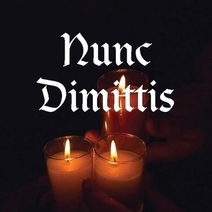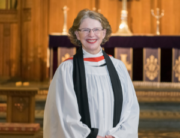The Presentation of Christ in the Temple
Luke 2:22-40
A Sermon by The Rev’d Canon Jenny Wilson

In the name of God, creating, redeeming, sanctifying… Amen.
Simeon keeps watch. This is his vocation. Steeped in the scriptures, this deeply religious man knows for what he is watching, though he may not know how it will present, what he will see. The Jewish scriptures speak of the covenant of the people with God, God who loves, who forgives, God who cares for justice especially for the widow, the orphan and the stranger in the land, who cares for the land. This God makes promises. God promises land and children and God promises the coming of one who will bring God’s kingdom of righteousness and peace. God promises a messiah.
And Simeon, who has spent his life in the temple, the place of worship and study and wrestling with the scriptures, this man believes that he will see this Messiah before he dies. He may well not know how this messiah will present himself, but Simeon keeps watch. His vocation is to keep watch, looking for what Luke describes in this evening’s second reading as “the consolation of Israel”.
When Mary and Joseph come to the temple, when the time comes for their purification according to the law of Moses, they bring Jesus up to Jerusalem to present him to the Lord and they offer a sacrifice according to what is stated in the law of the Lord, ‘a pair of turtle-doves or two young pigeons.’
Guided by the Spirit, Simeon comes at this time into the temple; and when these two parents bring in Jesus, to do for him what was customary under the law, Simeon knows, Simeon takes Jesus in his arms and praises God, saying, the words of the Nunc Dimittis that we heard our choir sing tonight. Simeon’s vocation is to keep watch. And then his vocation blossoms; for he then gives voice to what he sees.
Master,
now you are dismissing your servant in peace,
according to your word;
for my eyes have seen your salvation,
which you have prepared in the presence of all peoples,
a light for revelation to the Gentiles
and for glory to your people Israel.’
One writer said this of Simeon’s Song:
“The entire
song
is sung with the language of freedom.
In the original Greek text, it has the connotation of releasing a slave. Simeon
is describing his own experience as one of being released. In the song the word
“now” is of utmost importance, emphasizing that an experience of
profound liberation happened to him at that moment in time upon seeing the
Christ Child.
Simeon’s song is his way of describing how he was finally “released”
truly to live.”[1]
His vocation is honoured. He has seen the one he was made to see.
Our choir’s vocation is to sing. And as we gather today to hear them sing and to welcome their new Director of Music, Anthony Hunt, as he conducts them on the first of many times we will ponder that vocation for a moment.
The vocation to sing.
The St Peter’s Cathedral Choir sings the Nunc Dimittis each night when Choral Evensong takes place in our cathedral. As they sang Choral Evensong in many cathedrals in England during their recent tour. They sang services on two days in Chichester Cathedral, just hours after they had stepped off the plane from Australia; they sang five times in Canterbury Cathedral, the home of the Anglican church in the world;, they sang the Eucharist and Evensong at Westminster Abbey in the heart of London, and they sang Evensong twice in Coventry Cathedral, that cathedral that points so poignantly to the worst that human beings can do to one another and the best that human beings can do for one another as the new cathedral rises up there alongside the ruins of the old cathedral bombed in the Second World War. And then, finally, the choir sang the Nunc Dimittis at Choral Evensong in New College Oxford, before the Tour’s final celebration dinner in New College Dining Hall, hosted by our Music Foundation Patron, Michael Burden.
Yes, our choir sang. During the time that the choir was on tour in England, bush fires were raging at home. Day by day the news told stories of thousands of properties destroyed, of hundreds of millions of animals killed, of numbers of human lives lost. The images of the fires were seen in newsprint, television, online news and social media. Prayers were said for our country in each of the holy places in which our choir sang.
A tragedy was unfolding at home and here we were, far away in England, singing. And so we pondered that. The vocation to sing. Music, after all, holds our prayers. Music is a place in which our prayers can rest, can rage, can be expressed sometimes in bafflement and fear. Music holds our truth when sometimes words seem unable to do so. And so our choir sang, knowing that this was what God called them to do, even so far away from home, when home needed our prayers so dearly.
Seeing the messiah, holding the messiah, Jesus, Simeon spoke the words we know as the Nunc Dimittis and then he said a little more. Firstly he blessed Mary and Joseph. And then he told a little more of the truth of what lay ahead. Simeon said to his mother Mary,
This child is destined for the falling and the rising of many in Israel, and to be a sign that will be opposed so that the inner thoughts of many will be revealed—and a sword will pierce your own soul too.
Simeon somehow saw what life would be like for this baby messiah. Simeon spoke the hard truth of the struggle that lay ahead for him– and for those who loved him.
Simeon’s song. The Nunc Dimittis.
Remember what that writer that I quoted a little earlier said?
The entire song is sung with the language of freedom and has the connotation of releasing a slave. Simeon is describing his own experience as one of being released. In the song the word “now” is of utmost importance, emphasizing that an experience of profound liberation happened to him at that moment in time upon seeing the Christ Child.
It is as if God too is somehow set free in the world, released more deeply upon the world. God engaged with the world through the people Israel and now …God’s love for the world is to be sent into the whole world in this Jesus, this light for revelation to the Gentiles. The “Now” in Simeon’s song, this moment of profound realisation for him, is a moment when this truth is spoken into the world, when the Word of God, spoken into the world is named, revealed, messiah. The liberation of the world, which God will enact in Jesus’ life, death and resurrection is seen by Simeon in this baby and named in his song. And then, …his task is done. The purpose for which he was made by God is complete. Simeon may, indeed, depart in peace.
That how it is with vocations. With these lives God gives us. God sets in our hearts what we are made to be … for Simeon it was a life of praying and the scriptures and keeping watch. And sometimes, as it was for Simeon, there is a special moment, a particular day for which we wait almost all of our lives. A great truth to see and notice and witness to. The messiah being presented in the Temple. And sometimes our vocation is lived out every day, finds its expression often, blossoms each Sunday perhaps, in prayer, in song even.
Time, I think, to hear our choir again.
To treasure their vocation. The vocation to sing. And in the midst of their
song for us, this congregation, to rest, as God intended us to, in prayer.
[1] -Paul-Gordon Chandler – quoted in Edge of Enclosure – http://www.edgeofenclosure.org/christmas1bpresentation.html




